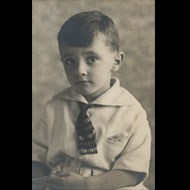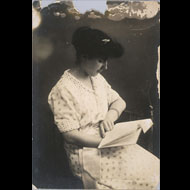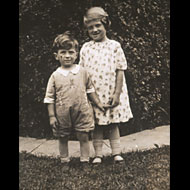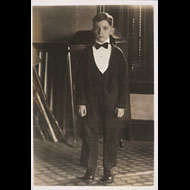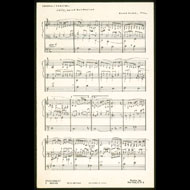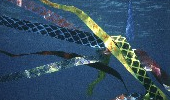Biographical Sketch of David Tudor (1926–1996)
David Tudor was born on January 20, 1926, in Philadelphia, Pennsylvania. He began piano study at the age of six with Caroline Clinton Cook, a local teacher, and organ lessons when he was eleven years old under H. William Hawke, the organist and choirmaster of St. Mark's Church in the nearby town of Swarthmore. Tudor's father, George, served as occasional organist at the family church, and his mother, Marian Witman, was a gifted pianist. Tudor had one sister, Joy, who now lives in Hawaii.

In May 1942, Tudor passed the theory examination to become an associate of the American Guild of Organists. In the fall of 1943, he assumed the position of organist at Trinity Church in Swarthmore, while also serving as organist at Swarthmore College (1945–47). When he was seventeen, Tudor heard a performance by the Rumanian-born pianist Irma Wolpe (born Schoenberg, later Rademacher) at Swarthmore and was inspired to begin piano studies with her. He quickly mastered the traditional piano literature, then gravitated toward the music of Wolpe's husband, the composer
Stefan Wolpe, with whom he prepared such demanding scores as
Battle Piece (1943–1947) for performance. Deemed medically unfit for military service in March 1944, Tudor pursued his performing career. He gave solo organ recitals at Trinity Church and, beginning in 1945, duo piano and chamber concerts primarily in New York City, featuring work by Wolpe, Arnold Schoenberg, Stravinsky, and other modernists. He also accompanied the dancers Katherine Litz and Jean Erdman.
 |
 |

Program for a recital by David Tudor and others in New York City American premiere performance of Pierre Boulez' Second Piano Sonata,
December 17, 1950
|
|
 |
The close exchange with Stefan Wolpe set the stage for Tudor's future collaborative work. On December 17, 1950, at Carnegie Recital Hall in New York, he gave the American premiere of
Pierre Boulez's Deuxième (1948), a technically demanding work that challenged classical forms and temporal continuity. The success of this performance propelled Tudor into the international spotlight and, the following year, into a position as pianist for a group of four young New York composers:
John Cage,
Morton Feldman (a former student of Wolpe's),
Earle Brown, and
Christian Wolff.
This group of experimentalists invented graphic scores for Tudor's realization
at the piano, using procedures of chance and indeterminacy. Each new piece challenged
his technical command and his practice of transforming the indeterminate graphics
and instructions into fully notated performance scores. Tudor held positions as
pianist-in-residence and instructor at Black Mountain College in Asheville, North
Carolina (summer sessions, 1951–1953) and at the Internationale Ferienkurse
für Neue Musik in Darmstadt, Germany (1956, 1958, 1959, 1961), where he introduced
works by composers of the American and European avant-gardes, including
La Monte Young,
Terry Riley,
Toshi Ichiyanagi,
Sylvano Bussotti, and
Karlheinz
Stockhausen. He performed piano and electronic music with the
Merce Cunningham Dance Company from its inception in the summer of 1953 and, upon
Cage's death in 1992, succeeded him as music director of the Cunningham Company.
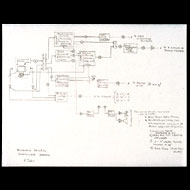 |
 |

David Tudor
Generalized electronic circuitry diagram for Bandoneon! (a combine), 1966
|
|
 |
Tudor's earliest original compositions, like his piano performance, emerged through collaboration. He created
Bandoneon! (a combine) for the performance series
"Nine evenings: theatre and engineering," held in October 1966 at the 69th Regiment
Armory in New York City and organized by Experiments in Art and Technology. Tudor
and his fellow participants, among them Cage, Lucinda Childs,
Öyvind Fahlström,
Yvonne Rainer, Robert Rauschenberg, and
Robert Whitman, worked with more than forty engineers and scientists from Bell Telephone
Laboratories to develop technical equipment utilized in the performances. The bandoneon produces audio signals programmed to activate television images, lighting, and moving loudspeakers. The subtitle, "a combine," invokes Rauschenberg's three-dimensional assemblages of
the 1960s and refers to the composite nature of Tudor's piece.
The interplay of electronic sound, visual imagery, and performance space also
guided Tudor's collaboration with sculptors
Robert Breer and
Forrest Myers and architect Whitman
on the Pepsi Pavilion at the Osaka World's Fair in 1970. Commissioned as one of
the core artists, Tudor conceived the interior of the pavilion dome as a sound
environment and, with the American composer Gordon Mumma, constructed an eight-channel
system that sent source sounds in every direction around the listener. His performed
installation
Rainforest IV grew out of his 1973 New Hampshire workshop
that included the musicians
John Driscoll,
Bill Viola, and
Ralph Jones. Tudor's program notes
instruct artists to drive source materials through resonant found objects, amplified
by means of small microphones (transducers). A pickup system distributes the new
resonances through the performance space, and the audience is invited to move
freely among the sculptures. In 1973 Tudor formed Composers Inside Electronics,
an ensemble dedicated to the composition and performance of live electronic music
using circuitry designed and built by the individual composers. Driscoll, Viola,
Jones, Paul De Marinis, Linda Fisher, Phil Edelstein, and Martin Kalve were members.
During the 1970s and 1980s, Tudor worked closely with the French artist
Jackie Matisse on installations for electronics and kite sculptures, including
Sea
Tails (1983),
Tailing a Dream (1985),
9 Lines, Reflected (1986), and
Lines and Reflections
(1988). From 1968 until his death, he regularly received commissions from
the Merce Cunningham Dance Company. His
Soundings: Ocean Diary (1994), together with
Andrew Culver orchestral score, constitutes the musical accompaniment to Cage and Cunningham's last collaboration,
Ocean, a work for dancers and large orchestral forces positioned around the audience. A film by
Molly Davies,
David Tudor's Ocean, documents Tudor's final performance with
the Cunningham troupe. He died in 1996 at his home in Tomkins Cove, New York.
Image Bank
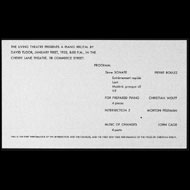 |

Program for a solo recital by David Tudor in New York City
First complete performance of John Cage's Music of Changes, January 1, 1952
|
|
 |
 |

La Monte Young
Autograph score of 0 - 1698 (April 1960) to Henry Flynt (excerpt),
1960
Courtesy of the artist
|
|
 |
 |
 |



